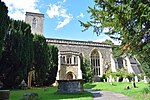St Edmund Hall, Oxford

St Edmund Hall (sometimes known as The Hall or informally as Teddy Hall) is a constituent college of the University of Oxford. The college claims to be "the oldest surviving academic society to house and educate undergraduates in any university" and was the last surviving medieval academic hall at the university.The college is on Queen's Lane and the High Street, in central Oxford. After more than seven centuries as a men-only college, it became coeducational in 1979. As of 2019, the college had a financial endowment of more than £65 million.Alumni of St Edmund Hall include diplomats Robert Macaire and Mark Sedwill, politicians Richard Onslow, 1st Baron Onslow, Keir Starmer and Mel Stride as well as journalists Samira Ahmed, (1986, English) and Anna Botting, (1986, Geography). The elected Honorary Fellows: Faith Wainwright, MBE FREng (1980, Engineering) and the Hon Justice Elizabeth Hollingworth (1984, BCL). In 2019, St Edmund Hall launched its 10 year strategy to improve access to higher education, increase the number of student scholarships, bursaries and academic fellowships at the Hall and improve its estate facilities and sustainability credentials. This was followed by the launch of HALLmarks, a £50 million campaign in 2022 to fundraise for a new student accommodation building at Norham Gardens, North Oxford as well as student support and fellowship endowment projects.
Excerpt from the Wikipedia article St Edmund Hall, Oxford (License: CC BY-SA 3.0, Authors, Images).St Edmund Hall, Oxford
Queen's Lane, Oxford City Centre
Geographical coordinates (GPS) Address Phone number Website Nearby Places Show on map
Geographical coordinates (GPS)
| Latitude | Longitude |
|---|---|
| N 51.753 ° | E -1.25 ° |
Address
St Edmund Hall (Teddy Hall)
Queen's Lane
OX1 4AR Oxford, City Centre
England, United Kingdom
Open on Google Maps










